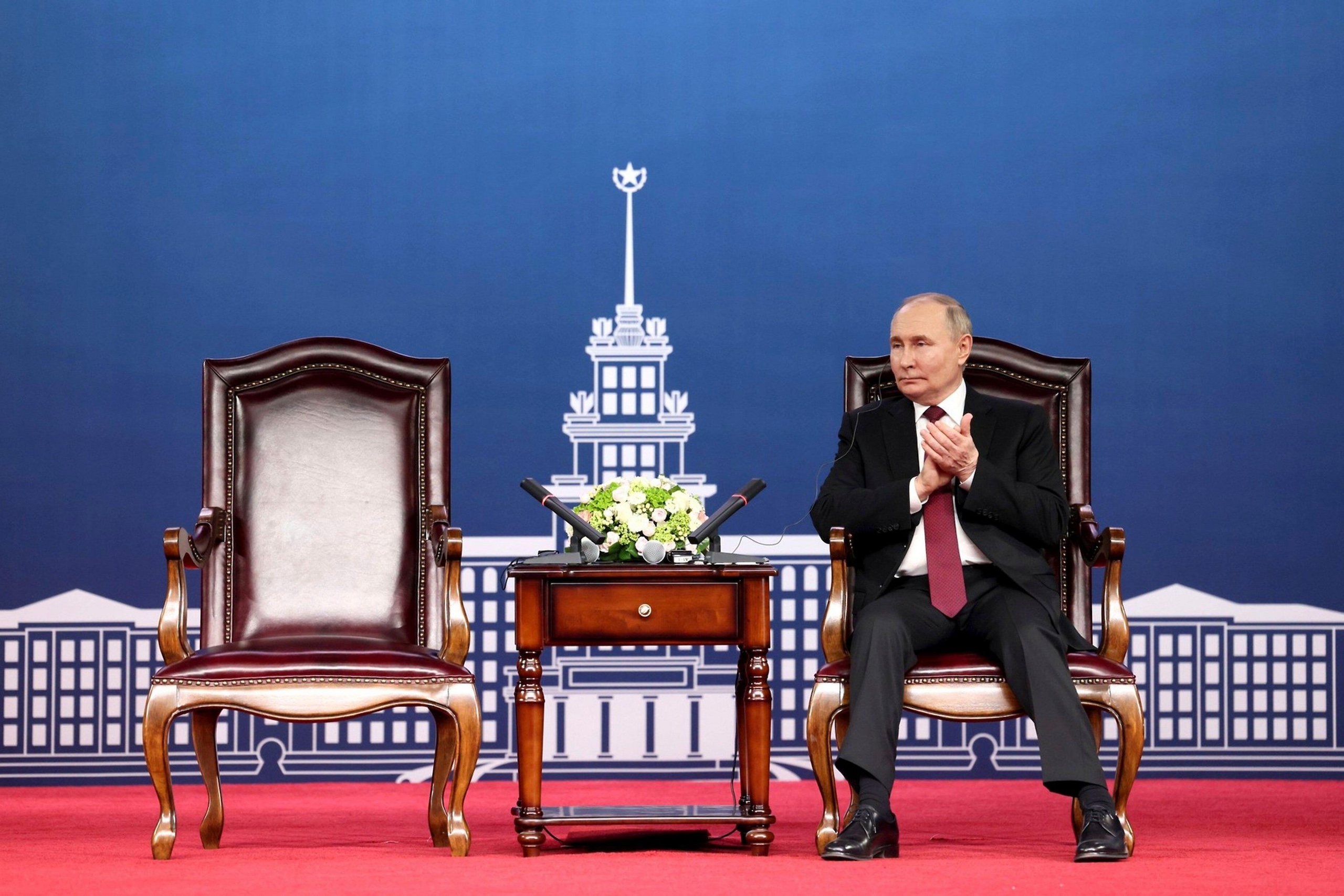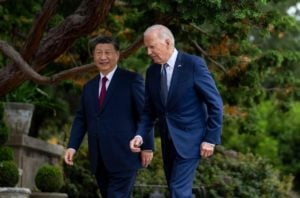In May, Russian president Vladimir Putin made the first official visit to China of his new term. A joint statement followed, heralding a “new era” in Sino-Russian relations, and marking the 75th anniversary of diplomatic ties. This document underscored the deepening “no limits” partnership between the two nations, announced during Putin’s February 2022 state visit, and cemented by economic interests and mutual distrust of the west – especially in the aftermath of Russia’s invasion of Ukraine.
Notably absent from the joint statement was the green agenda, including clean energy development and other climate action. This omission raises eyebrows at a time when China strategically positions green issues at the forefront of its diplomacy. The statement’s references to climate change are tepid, with emphasis put on nations’ “common but differentiated responsibilities” towards climate action under the UN climate convention and Paris Agreement.
The only direct mention of “green transformation” was in the context of the Asia-Pacific region, and was devoid of substantive proposals. Additionally, the joint statement contains both parties’ opposition to linking climate issues to international peace and security threats, signalling a lack of seriousness in facing climate risks. References to renewable energy were sparse and couched in vague language about deepening cooperation.
By contrast, President Xi Jinping’s European tour that same month, which included visits to Hungary, Serbia and France, showcased China’s green diplomacy and led to significant developments. Leading Chinese car maker BYD inaugurated its first European electric vehicle factory in Hungary. There was a USD 2.1 billion investment in Serbia’s renewable energy sector. And green development was one of 18 cooperation agreements signed between China and France.
Engaging in climate action, particularly through green-tech-focused initiatives, is increasingly central to China’s global diplomatic charm offensive. But when it comes to Russia, climate action might be the weakest link in a purported boundless relationship. Why is this happening and what are the implications?
Hydrocarbon bind
A convincing interpretation of the scant climate focus in the Sino-Russian joint statement is that environmental issues are subordinate to the strategic imperative of countering US influence. The document emphasises the “fundamental interests” (根本利益, gēn běn lì yì) of the Chinese and Russian people. The alliance is deeply rooted in mutual mistrust of American power, shared material interests in trading fossil fuels and military technology, and ideals regarding the merits of authoritarian political regimes pursuing state-directed development plans.
One of China and Russia’s “fundamental interests” rests on the hydrocarbon trade of crude oil, coal and natural gas, which brought economic security to Russia and energy security to China. Political repercussions from the invasion of Ukraine severely impacted Russia’s traditional energy market in Europe. Pipeline deliveries of gas and oil have decreased by over 80%, while coal exports have virtually ceased following an EU ban on purchases of new Russian coal. Gazprom, the Kremlin-owned gas company, saw its natural gas supplies to Europe drop by 55.6% in 2023, leading to a significant financial setback of nearly USD 7 billion.
No greenwashing can hide the fact that China and Russia engage in a substantial fossil fuel tradeXie Chengkai
Russia turned to other markets to remedy the loss of revenue. Sino-Russian trade surged to a new record of USD 240 billion in 2023, driven by China’s increased intake of Russian hydrocarbons. China received a one-third increase in Russian crude oil shipments between 2021 and 2023, while LNG and coal exports almost doubled during that same period. In 2023, Russia overtook Saudi Arabia to become the largest source of Chinese oil imports.
No greenwashing can hide the fact that China and Russia engage in a substantial fossil fuel trade. One may explain the absence of climate ambition in May’s joint statement to be part of China’s efforts to increase its energy security by importing cheap Russian fossil fuel.
Mismatched climate commitment
The lack of climate considerations also highlights divergent stances and leadership on environmental issues, climate change and decarbonisation goals. As recently as 2019, Putin continued to assert that “no one knows the true cause of climate change” and that determining how human activity affects it is “very difficult, if not impossible.” Worse still, in the 2023 update of its 2009 climate doctrine, the Kremlin removed language stating human activity is “primarily associated” with emissions “from the combustion of fossil fuels”. With fossil fuels central to its energy strategy, Russia’s renewable energy targets and current share fall below 5%. This undermines the Paris Agreement’s higher-ambition, 1.5C target.
Conversely, China, while the world’s largest emitter of greenhouse gases, has emerged as a leader in green technology. For example, the country is behind over 80% of the global solar equipment supply chain. President Xi’s enthusiastic embrace of “ecological civilisation” in 2017 laid the foundation for China’s “dual carbon” goals, aiming for carbon peaking by 2030 and neutrality before 2060. Forecasts suggest China’s CO2 emissions are set to fall in 2024, driven by substantial growth in low-carbon energy installations. For the first time, non-fossil energy sources surpassed 50% of China’s total electricity-generation capacity in 2023.
Xi’s catchphrase, “green mountains are gold mountains and silver mountains,” exemplifies the dual approach of protecting the environment and promoting economic development. Beijing, unlike Moscow, has succeeded in making renewable energy a pillar of its economy, having established a robust low-carbon industrial sector. With clean-energy industries contributing 40% of China’s GDP growth in 2023, they emerged as the main engine of the country’s economic expansion.
Regarding exerting global leadership, China and the US created a new framework for their climate commitments with the 2023 Sunnylands Statement. It was said to have enabled the adoption of UN climate conference COP28’s final language of “transitioning away from fossil fuels”. While COP28 was taking place in the United Arab Emirates, Putin arrived there to strengthen OPEC+ cooperation and further discuss trade and oil. The contrast was striking.
Transitioning apart
The missing green agenda risks undermining Sino-Russian relations in the medium term. China’s renewable-energy infrastructure will reduce its reliance on Russian energy supplies, putting the two countries’ hydrocarbon trading relations at risk. Even though China’s oil and gas demand has grown steadily over past decades, the International Energy Agency’s World Energy Outlook 2023 found that China’s fossil-fuel use would peak in 2024 before entering slow structural decline. Putin’s highly anticipated Power of Siberia 2 pipeline is set to transport 50 billion cubic metres of natural gas per year from Russia to China. The project would offset nearly half of the decline in Russian pipeline gas exports to the EU between 2021 and 2023, but was snubbed by Beijing during recent visits. Beijing’s calculated silence on the proposed pipeline is almost certainly intended to drive a better bargain around price and supply-chain control with an impatient Moscow.
However, the continuous growth of clean technology, including batteries, will reduce China’s fossil fuel dependence on Russia. China’s rapid battery development will improve grid-energy storage, alleviating the renewable energy curtailment (or wastage) problem. Advanced battery technology will also lead to more durable electric vehicles and greater usage of new-energy vehicles, reducing crude-oil consumption for passenger cars. Furthermore, China’s ambition to expand its renewable footprint into neighbouring countries, such as Mongolia, where the Power of Siberia 2 will be built and developed, could become a sensitive spot in Sino-Russian relations.
China and Russia’s different stances on climate change is a potential weakness and constraint in the relationship
Despite Russia’s meagre renewable energy share and nascent carbon market, there exists scope for collaboration in hydrogen energy, leveraging Russia’s natural gas reserves. A blue hydrogen project on Sakhalin Island in eastern Russia is actively courting Chinese investment, having secured a deal with a Chinese energy equipment supplier for technology and hydrogen exports to China. However, as China ramps up its domestic hydrogen capacity, the extent of its enthusiasm for cooperation remains uncertain.
A further source of clean energy is nuclear power, which accounts for more than 19% of Russia’s electricity generation. Putin mentioned the sector during the visit but it did not appear in the joint statement. Last year, China and Russia signed an agreement to deepen their nuclear energy cooperation, especially in developing fast reactors and producing uranium-plutonium fuel. According to the China Aerospace Studies Institute, “nuclear energy is a rare area where Russia continues to play the more senior role.”
There is little doubt that Russia and China’s “no-limit” friendship is deeply rooted in geopolitics, political strategy and hydrocarbon trade. But the countries’ different stances on climate change, and the resulting gap in their partnership, is a potential weakness and constraint in the relationship.









